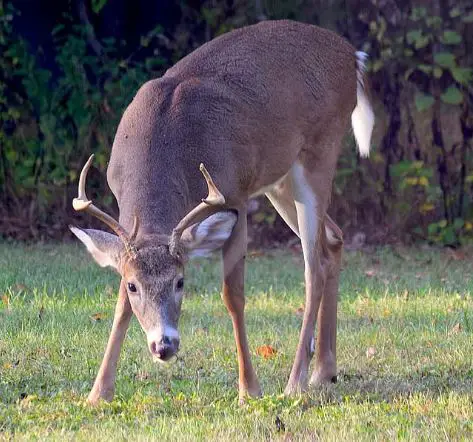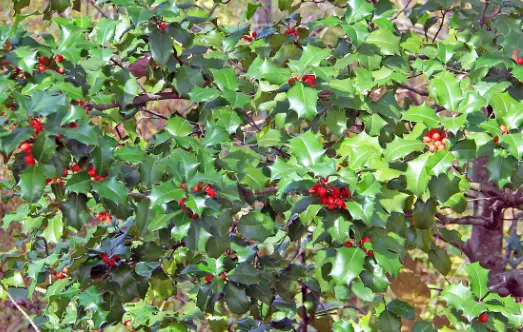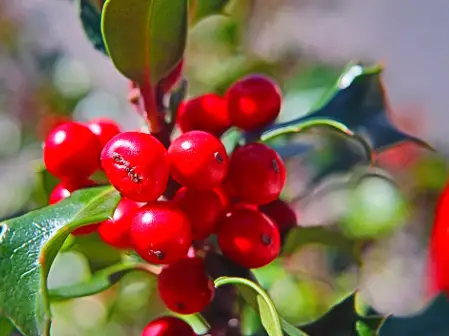Deer are known to be voracious eaters, and their diet includes a wide variety of plants and shrubs. One question that often arises among gardeners and homeowners is whether deer eat holly. Holly is a popular evergreen shrub that is commonly grown for its attractive foliage and berries. It is also a favorite among landscapers for its ability to provide privacy and serve as a natural fence. So do deer eat holly?
The answer is not a straightforward yes or no. While some species of holly are more resistant to deer than others, there is no guarantee that deer will not eat them. In this article, we will explore the relationship between deer and holly and provide some tips on how to protect your holly plants from deer damage.
Do Deer Eat Holly?

Hollies are a popular choice for landscaping due to their evergreen foliage, attractive berries, and low maintenance requirements. However, deer can be a significant problem for gardeners who wish to grow hollies.
Deer-Resistant Hollies
While deer will eat almost anything when they are hungry, there are some holly varieties that are less attractive to deer than others. Some deer-resistant holly varieties include:
- American Holly (Ilex opaca)
- Inkberry Holly (Ilex glabra)
- Foster Holly (Ilex x attenuata)
- Nellie R. Stevens Holly (Ilex x ‘Nellie R. Stevens’)
- Yaupon Holly (Ilex vomitoria)
It is important to note that no holly variety is completely deer-proof, and hungry deer may still nibble on these plants if other food sources are scarce. However, planting deer-resistant hollies can help reduce the risk of significant damage to your garden.
In addition to planting deer-resistant hollies, there are other steps you can take to discourage deer from eating your plants. These include:
- Installing physical barriers, such as fences or netting, around your garden
- Using deer repellents, such as sprays or granules, that contain ingredients that deer find unpleasant
- Planting other deer-resistant plants alongside your hollies to create a less attractive environment for deer
By taking these steps, you can help protect your hollies and other garden plants from hungry deer.
Types of Holly

Holly is a popular evergreen shrub that is known for its glossy green leaves and bright red berries. There are many different types of holly, each with its own unique characteristics. Here are some of the most common types of holly:
American Holly
American holly (Ilex opaca) is a native holly species that can be found in the eastern United States. It is a slow-growing shrub that can reach up to 50 feet in height. American holly has dark green leaves with spiny edges and produces bright red berries in the winter.
Japanese Holly
Japanese holly (Ilex crenata) is a small, slow-growing shrub that is native to Japan and Korea. It has small, dark green leaves and produces small black berries. Japanese holly is often used as a hedge or border plant.
Blue Holly
Blue holly (Ilex x meserveae) is a hybrid holly that is a cross between English holly and Chinese holly. It has blue-green leaves with spiny edges and produces bright red berries. Blue holly is often used as a decorative plant in gardens and landscapes.
Inkberry
Inkberry (Ilex glabra) is a native holly species that can be found in the eastern United States. It is a small, slow-growing shrub that has dark green leaves and produces black berries. Inkberry is often used in wetland restoration projects.
Yaupon
Yaupon (Ilex vomitoria) is a native holly species that can be found in the southeastern United States. It is a small, slow-growing shrub that has small, dark green leaves and produces bright red berries. Yaupon is often used as a decorative plant in gardens and landscapes.
English Holly
English holly (Ilex aquifolium) is a holly species that is native to Europe and western Asia. It has dark green leaves with spiny edges and produces bright red berries. English holly is often used as a decorative plant in gardens and landscapes.
Chinese Holly
Chinese holly (Ilex cornuta) is a holly species that is native to China and Korea. It has dark green leaves with spiny edges and produces bright red berries. Chinese holly is often used as a hedge or border plant.
Winterberry Holly
Winterberry holly (Ilex verticillata) is a native holly species that can be found in the eastern United States. It is a deciduous shrub that has dark green leaves and produces bright red berries in the winter. Winterberry holly is often used as a decorative plant in gardens and landscapes.
In conclusion, holly is a versatile and beautiful plant that comes in many different varieties. Whether you are looking for a hedge, a border plant, or a decorative shrub, there is a type of holly that will suit your needs.
Deer Damage to Holly

Holly is a popular evergreen shrub that is commonly grown in gardens and landscapes. Unfortunately, deer are known to browse on holly plants, especially during the winter months when other food sources are scarce. In this section, we will discuss the symptoms of deer damage to holly and ways to prevent it.
Deer Damage Symptoms
Deer damage to holly can manifest in various ways, including:
- Browsing on leaves and stems: Deer will eat the tender leaves and stems of holly plants, leaving behind ragged edges and uneven growth.
- Broken branches: Deer can break branches while browsing or rubbing their antlers on the plants.
- Damage to bark: Deer can cause damage to the bark of holly plants, which can lead to stunted growth or even death.
How To Keep Deer From Eating Holly
There are a few things to keep in mind when you’re protecting holly from hungry deer: their habits, your scent, repellent options, and when you plant them.
Deer will eat nearly anything if they’re hungry enough, so your main goal is making your garden as least inviting to deer as possible.
Check out our guide on how to protect your garden from deer where we cover 25 quick and easy tips for keeping hungry deer out of your garden.
Holly Toxicity to Deer

Deer are known to be herbivores, and they feed on a variety of plants to meet their nutritional needs. However, some plants can be toxic to deer, and holly is one of them. Holly plants contain toxic compounds that can cause unpleasant reactions in deer if ingested.
Toxicity Symptoms
Deer that eat holly berries can experience vomiting, diarrhea, and other gastrointestinal problems. Holly berries contain theobromine, a compound that is also found in chocolate and can cause vomiting and diarrhea in animals. The symptoms of holly toxicity in deer can range from mild to severe, depending on the amount of berries ingested and the deer’s overall health.
It is important to note that not all holly plants are equally toxic to deer. Some holly species have more toxic compounds than others, and the toxicity can also vary depending on the time of year and the maturity of the plant. Additionally, young deer and fawns may be more susceptible to holly toxicity than adult deer.
To prevent deer from eating holly plants, gardeners can choose holly species that are less attractive to deer or protect their plants with physical barriers or repellents. It is also important to note that while holly can be toxic to deer, it is not a reliable method of controlling deer populations and should not be relied upon as such.
In conclusion, holly can be toxic to deer and can cause vomiting, diarrhea, and other gastrointestinal problems. Gardeners should be aware of the potential toxicity of holly plants and take appropriate measures to protect their plants and prevent deer from ingesting them.
Will Hollies Come Back If Eaten By Deer?
Hollies are generally hardy plants that can withstand some damage caused by deer. If deer have eaten the foliage of a holly plant, the good news is that the plant can recover from the damage. However, the extent of the damage and the timing of the pruning can affect the recovery of the plant.
Pruning is an essential part of maintaining holly plants, and it can help the plant recover from deer damage. If the deer have eaten the foliage of the holly plant, it is recommended to prune the plant back to healthy growth. Pruning can help the plant focus its energy on new growth and recover from the damage caused by the deer.
Hollies have a milky sap that can be toxic to deer, which makes them less likely to eat the plant. However, hungry deer may still nibble on the plant, especially during the winter months when food is scarce. If the deer have eaten the bark of the holly plant, it can cause more significant damage, and the plant may not be able to recover.
Holly plants have prickly leaves that can deter deer from eating them. However, some deer may still try to eat the plant, especially if they are hungry. If the deer have eaten the leaves of the holly plant, it can cause damage to the plant, but it is not usually fatal.
In conclusion, holly plants can recover from damage caused by deer, but the extent of the damage and the timing of the pruning can affect the recovery of the plant. Pruning is an essential part of maintaining holly plants and can help the plant recover from deer damage. Hollies have a milky sap and prickly leaves that can deter deer from eating them, but hungry deer may still try to eat the plant.
Check out our other helpful garden guides while you’re here:

